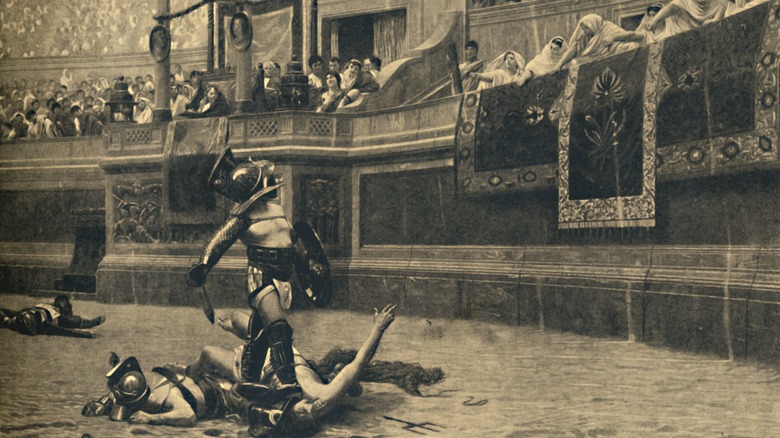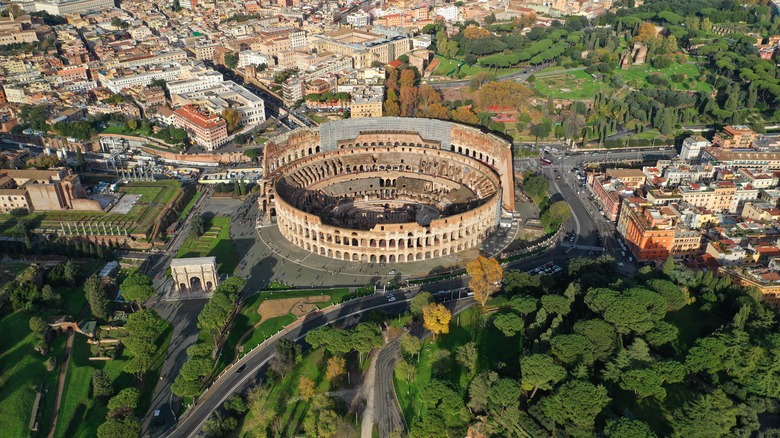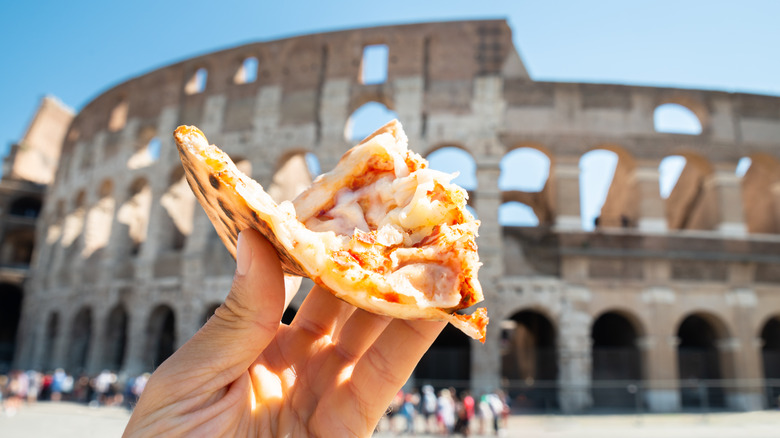What Ancient Roman Spectators Snacked On At The Colosseum
The ancient Roman Colosseum was, in many ways, the progenitor of modern sports arenas. It's true, obviously, that gladiator fights to the death are a thing of the distant past, as are fights pitting men against lions and other terrifying creatures. But if we shift the focus from the combatants — or competitors, in today's sporting world — to the spectators, then it's clear that little has changed in almost 2,000 years.
The Roman Colosseum, like many of today's sporting stadiums, was massive, with a capacity of well over 50,000 spectators. Ancient Roman sources, in fact, put the number closer to 90,000. As with modern arenas, there were multiple entrances to prevent overcrowding at individual gates. The Roman Colosseum, for example, boasted no less than 80 of them. Then, as now, entertainment and excitement were the main stadium attractions.
The only thing that seems to have changed radically, from antiquity to modernity — other than the sports contests themselves — is the snack menu. Today, spectators can nosh on hot dogs, nachos, pretzels, or other arena-style fares. In ancient Rome, the snacks were much likelier to be fruits, although archaeological finds in recent years have shown that some of the ancient options, like pizza, were quite similar to snacks still enjoyed today.
Typical snack items at the Roman Colosseum
Attendees at ancient events in Rome's Colosseum, which opened in 80 A.D., were treated to more than just gladiator games. Comedic spectacles, wild animal hunts, and sometimes even public executions were also part of the entertainment, which was staged over the course of each day. Thus, for many spectators, visits were an all-day outing. That meant fruity snacks such as blackberries, cherries, figs, grapes, olives, peaches, and plums, which could stave off hunger pangs, were popular treats at the Colosseum. So, too, were hazelnuts and walnuts for the same reason.
But more filling fare was also available. Meat was cooked on braziers, an early version of an outdoor grill, and presumably served in concession stands. In 2011, for example, archeologists in Austria discovered a Roman gladiator school, as well as a nearby amphitheater with concession stands. So we know that ancient vendors operated much like those today. There was even an oven on hand for baking bread and cauldrons for warming food.
The discovery of Roman snack habits at the much larger Colosseum is also quite recent and dates to a 2021 project initiated by archaeologists, who used robots to investigate the stadium's ancient passageways and sewers. Old coins were also found, and it can be assumed that ancient snacks, like those of today, were sold for a profit. The most shocking discovery, however, was that pizza was among the snack foods available to spectators at the Colosseum.
What kind of pizza was served at the Roman Colosseum?
The recent discoveries uncovered by archaeologists at the Roman Colosseum date to the year 170, and include evidence that not just meat was cooked on braziers, but also pizza. Yes, this means people were eating pizza at least 1,850 years ago. But this is not exactly new knowledge. It has been well-established that ancient Greeks, Egyptians, and Romans all ate pizza.
Ancient pizza, however, was not quite the same as the pepperoni pies ordered from Domino's Pizza or Pizza Hut. The ancient version was basically flatbread with a few toppings. The dough for Roman pizza, for example — called pinsa — was made from unnamed grains and water, plus a little salt, and was fashioned into an oval shape before being cooked. Cheese was an occasional topping of the time, as were herbs and olive oil.
There is no evidence to confirm the toppings for pizzas at the Colosseum, but given that animal remains from chicken and pigs were discovered, these would be among the most likely "meat lover" options. Perhaps more evidence will come to light in future years. The Colosseum remained in use until 523, and due to its massive size — it covers six acres — more discoveries seem inevitable. Who knows? Maybe we'll find that Romans and their emperors ate hot dogs, too.
There's already enough evidence, however, based on recent findings, that they were among the earliest connoisseurs of delicious stadium snack food.



